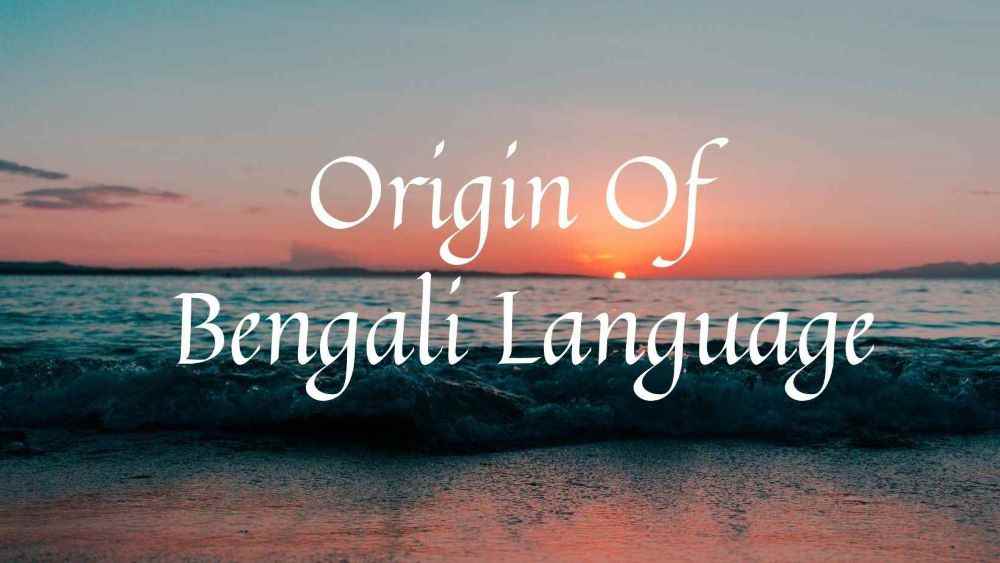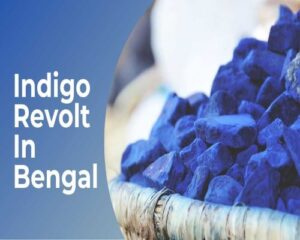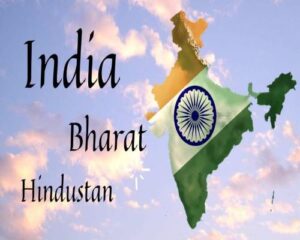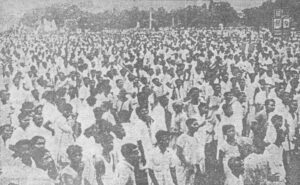Bengali, the sweetest language, is the sixth most spoken language in the world. People in the Bengal region not always spoke Bengali. Then, how Bengali came into existence and what is the origin of the Bengali language.

The Bengali language is derived from Sanskrit. However, early Sanskrit texts suggest that in ancient times the people of Bengal did not converse in Sanskritic languages. In 1318 the poet Amir Khusrau noted that in the Bengal region, people used to communicate in the Gauri language. How, then, did the new language Bengali emerge in the region?
Languages Used In Ancient Bengal
Commercial relations between Bengal and Magadha (South Bihar) began to emerge in the fourth and third century BCE (400 BCE-201 BCE), which may have led to the spread of Sanskrit in the region.
The Gupta emperors acquired political dominance over north Bengal in the fourth century and began to settle Brahmanas in the region. As a result, the mid-Ganga valley’s language and cultural impact grew stronger in the area.
Even though Hindu Brahmins in Bengal spoke Sanskrit, the local Buddhist community spoke a variety of Prakrita languages.
Xuan Zang, a Chinese traveler, observed in the seventh century that Sanskrit-related languages were in use throughout Bengal.
From the eighth century, Bengal became the center under the regional kingdom of Palas. Between the fourteenth and sixteenth centuries, Sultans ruled Bengal. They were independent of the rulers in Delhi.
Evolution OF Bengali Language
In 1586, when Akbar conquered Bengal, Persian became the language of administration. Simultaneously, Bengali developed as a regional language. Bengali gained many vocabularies from Arabic and Persian, which cultivated a manifestation of Islamic culture on the language.
By the fifteenth century, the Bengali dialects had developed a single literary language based on the spoken language in the western region of Bengal. Because Bengali is a natural language, no one can claim to have invented it.
As a result, while Bengali is derived from Sanskrit, it went through several stages of evolution. Several non-Sanskrit words, derived from a variety of sources such as tribal languages, Persian, and European languages, have also become part of modern Bengali.
The modern Bengali vocabulary is based on Sanskrit, Prakrit, Pali, and Magadhi, with significant borrowings from Arabic, Persian, and other languages in contact.
Early Bengali Literature
Early Bengali literature can be split into two categories: those influenced by Sanskrit and those that are not.
The first category includes Sanskrit epic translations, Mangalakavyas (auspicious poems about local deities), and bhakti literature like Chaitanyadeva’s biography.
The second section contains Nath literature such as Maynamati and Gopichandra’s songs, stories about popular regional deity Dharma Thakur, fairy tales, folk tales, and ballads.
The first category of texts is easier to date because several manuscripts have been discovered indicating that they were written between the late fifteenth and mid-eighteenth centuries. Those in the second category were passed down orally and cannot be precisely dated. They were popular in eastern Bengal.
There is widespread agreement that in the distant past, Oriya, Assamese, Bihari, and Bengali formed a single branch, from which Oriya was the first to split, followed by Assamese. That is one of the reasons why the Charyapadas (Buddhist mystic songs), the first specimens of Bengali language and literature, are also claimed as their own by speakers of Oriya and Assamese.
In the 16th century, the first native name for Bengali was Gauda-bhasa. It became popular as Vanga-bhasa in the nineteenth century. It is now known as Bangla-bhasa.
Modern Bengali Language
Bengali has developed over more than 1,300 years. Bengali was extensively developed during the Bengali Renaissance.
Bengali’s modern literary form emerged in the late nineteenth and early twentieth centuries.
There were two main forms of modern Bengali language:
- Cholitobhasha – A colloquial form of Bengali used in daily communication. It is based on the dialect spoken in the Shantipur region in the Nadia district. This style gained popularity around the turn of the century, thanks to the writings of Peary Chand Mitra, Pramatha Chaudhuri, and later Rabindranath Tagore.
- Sadhubhasha – The Sanskritised form of Bengali. India’s national anthem Jana Gana Mana, written by Rabindranath Tagore, was composed in this form. Its use in modern writing, on the other hand, is infrequent, limited to a few official signs and documents in Bangladesh, and for producing specific literary effects. The language of early Bengali poetical works influenced the former greatly.
Modern Bengali literature was founded by Michael Madhusudan Dutta and Bankim Chandra Chatterjee.
Bengali Language Movement
The Bengali language movement began in 1948 when the Pakistani government attempted to impose Urdu as the country’s sole official language. Bangladeshis had been demanding for a long that Bengali become an official language of Pakistan. It fueled Bengali nationalism in East Bengal, eventually contributing to the creation of Bangladesh in 1971.
The Bengali Language movement was a popular ethnolinguistic movement in the former East Bengal (now Bangladesh) that sprang from Bengalis’ strong linguistic consciousness to seek and maintain Bengali’s designation as a state language.
Bengali Community Around The World
Today, around 98 percent of people in Bangladesh have Bengali as their first language.
Bengali is the second most spoken language in India. It is the official language of the states of West Bengal, Tripura, and the Barak Valley region of Assam. Sizeable minorities of Bengali speakers reside in Indian cities outside Bengal, such as Bengaluru, Mumbai, Delhi, Jamshedpur, Varanasi, and Ranchi. Over 13 Lakh Bengalis have made their second home In Bengaluru. Bengali is also spoken by the significant global Bengali diaspora communities in Pakistan, the United Kingdom, the United States, and the Middle East. London is home to a large Bengali diaspora.










